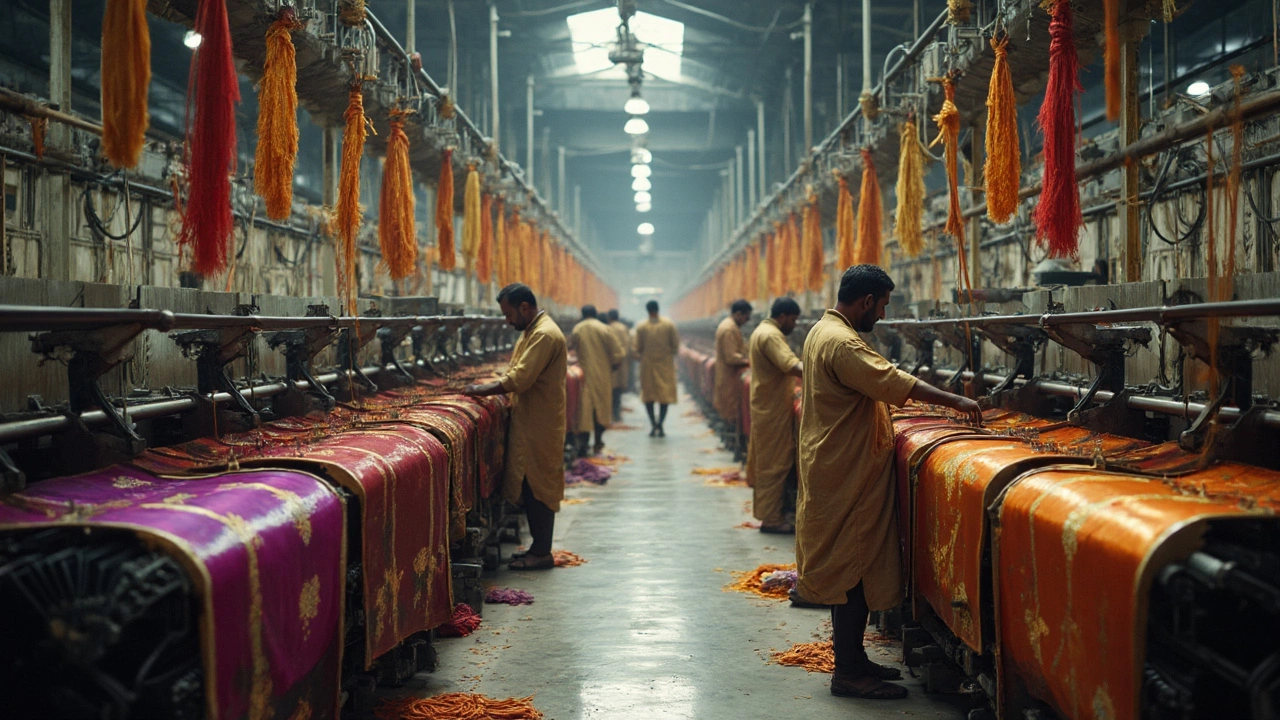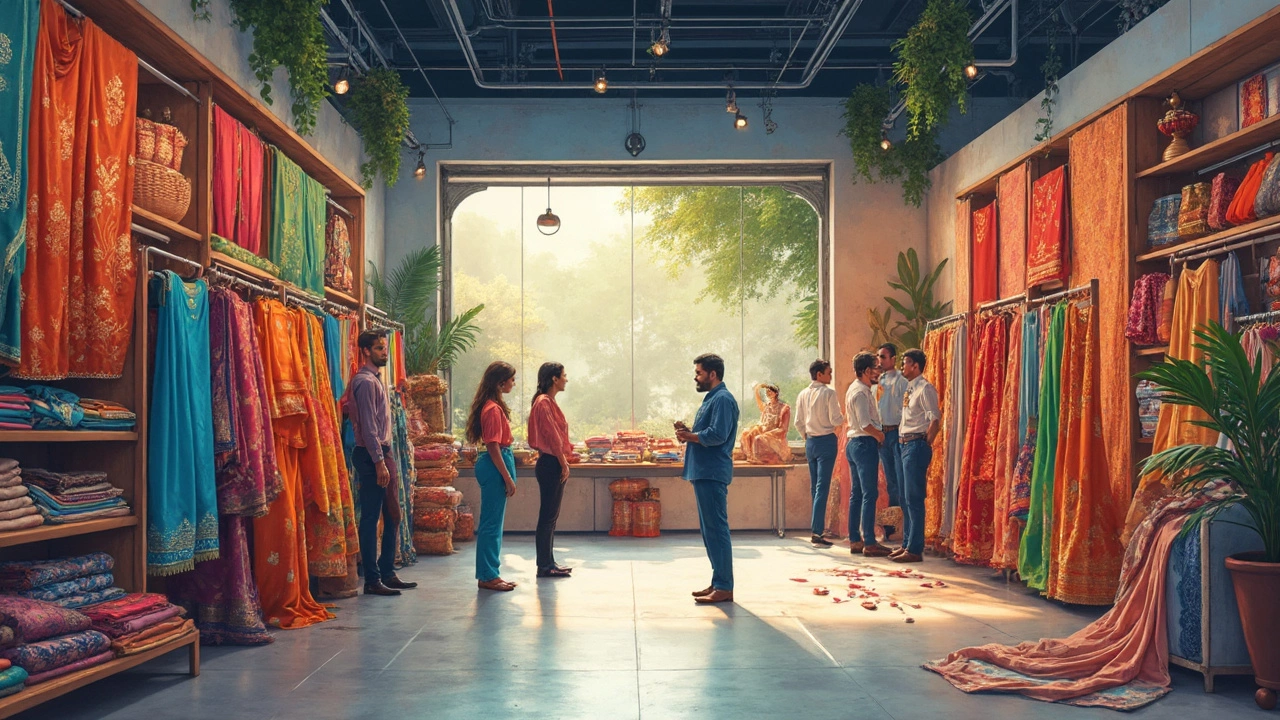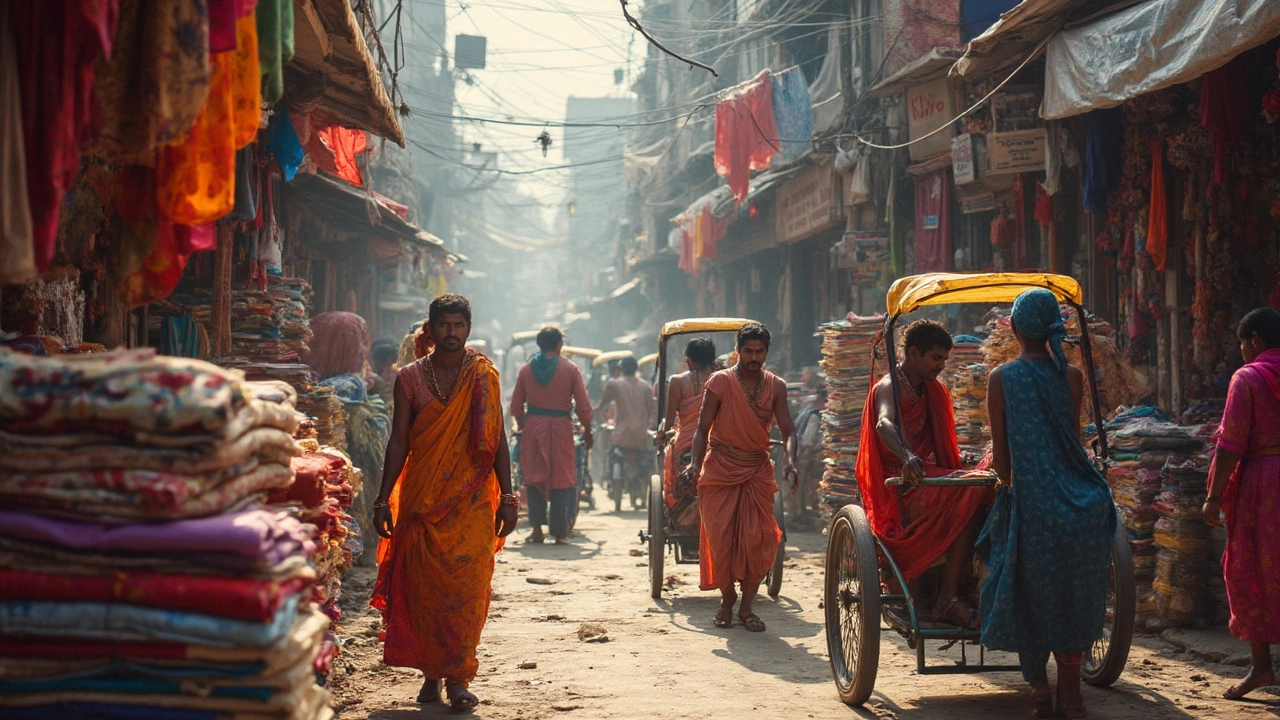Ask anyone who works in fabrics, and you’ll hear the same answer every time—the crown for textile capital of India sits with Surat, a city tucked away in the state of Gujarat. This place is basically the engine room for every saree, dress material, and synthetic fabric rolling out across India and even overseas. When my son Tanishq first heard how much cloth comes out of Surat—roughly 30 million meters every day—he looked like he’d seen a magic trick.
If you’re thinking about jumping into the textile game in India, or you just want to know where all those vibrant clothes in the markets actually start out, Surat is the name you need to remember. The city isn’t famous just because of the volume. The local manufacturers are super quick to adopt new technology and styles. You’ll find everything from traditional weaving to full-on computerized embroidery machines churning out the latest trends.
- Where Is the Textile Capital of India?
- How Surat Grew Into the Leader
- Unique Features of Surat’s Textile Scene
- What It Means for Manufacturers and Buyers
- Smart Tips for Working With Surat’s Textile Industry
Where Is the Textile Capital of India?
Let’s settle the big question—if you want to see where Indian fabrics really begin, you’ve got to look at Surat, in Gujarat. Ask anyone dealing in fabrics or even big textile business owners, and Surat is the place they’ll mention first. This city isn’t just a casual player; it leads the game in sheer production and the speed at which it moves.
Surat is called the “Silk City” and the “Diamond City,” but these days, its real fame comes from textiles. Roughly 90% of India’s polyester fabric is made here. That’s not just a random stat; it comes straight from the Southern Gujarat Chamber of Commerce and Industry (SGCCI). Want another jaw-dropping number? Surat’s textile market clocks more than $100 billion turnover every year.
"Surat is not just a city, it’s the pulse of India’s textile heartbeat." — S. K. Jain, Chairman, Southern Gujarat Chamber of Commerce
People sometimes think of Mumbai, Coimbatore, or even Ludhiana, but if you look at raw numbers, from fabric produced to jobs created, Surat stands far ahead. It’s not a recent sprint, either—Surat’s been hustling in the textile business for decades, building up networks of small and big mills, dyeing factories, and design studios.
| City | Annual Textile Production (meters) | Key Products | Number of Textile Units |
|---|---|---|---|
| Surat | Approx. 28-30 billion | Polyester, Sarees, Dress Material | 600,000+ |
| Coimbatore | Approx. 3 billion | Cotton Yarn, Knitwear | 100,000+ |
| Ludhiana | Approx. 1 billion | Woolens, Knitwear | 15,000+ |
You’ll find wholesale shops packed with fabrics, family-run dyeing houses side by side with giant weaving factories, and transport hubs sending material all over the country. If you look for the textile capital of India, all roads lead to Surat.
How Surat Grew Into the Leader
Surat didn’t get its title overnight. Back in the 1970s, most of India looked to Mumbai for textiles. But Surat started pulling ahead when local families invested big in power looms. These machines let them make fabric quickly and at a scale nobody thought possible back then. Pretty soon, tiny workshops grew into massive complexes—some with over a thousand looms under one roof. Today, Surat’s clusters number over 4,500 weaving units and 400 processing plants. Now, that’s a lot of fabric action in one place.
The other big break? Location. Surat is close to major ports and has solid rail links. Exporting goods from here is pretty smooth—so whether you’re shipping to Delhi or Dubai, it doesn’t slow manufacturers down. It makes a massive difference if you’re fighting tight deadlines, which in fashion is almost always the case.
If you peek into the history books, you’ll also find Surat was trading silk and cotton way back in the Mughal times. The city’s always had a business-first attitude—almost everyone here knows someone who works with fabric, from dyeing to sales. You’ll spot father-son duos running the same stalls, with the kids handling the latest WhatsApp orders while the dads haggle in the back room.
Let’s talk numbers, since that always tells the real story. Here’s what the textile capital of India churns out these days:
| Category | Output per Day |
|---|---|
| Synthetic Fabric | 30 million meters |
| Man-made Fibre Textiles | Over 60% of India's total |
| Workforce | Roughly 650,000 people |
| Export Countries | Over 100 worldwide |
What’s wild is how Surat handled setbacks too. The city’s textile owners bounced back after big floods and a massive fire in the 1990s, rebuilding smarter with better safety and newer machines. They also hopped on digital payments and online trade faster than most old-school markets. So if you’re planning to get involved with textiles, this city proves there’s a solid business mindset driving it forward, not just tradition.

Unique Features of Surat’s Textile Scene
Surat isn’t just a big player in the world of textiles—it’s a trendsetter for the whole country. The city’s main strength is its insane variety. Whether it’s polyester, viscose, fancy sarees, or ready-to-stitch dress material, Surat has it all. It's the place where you can spot a powerloom machine whirring away next to a traditional weaving unit, both working side by side to meet the demand for both standard and custom orders.
One thing that stands out is speed. Surat is famous for its quick turnaround times. A new pattern’s trending? They’ll have it in the market before you’ve even finished your breakfast. Local units run around the clock, using everything from basic tools to high-tech digital printing, making it possible to mass-produce and deliver at lightning speed. That’s why fashion wholesalers and retailers from all over India keep coming back.
The supply chain here is hyper-connected. Yarn spinning, dyeing, weaving, embossing, embroidery—it all happens a stone’s throw from each other. There are entire neighborhoods dedicated to just one process, which keeps prices competitive and logistics simple. On top of that, Surat factories are no strangers to exports. They ship out fabrics, sarees, and dress materials to Africa, the Middle East, Bangladesh, and beyond.
Surat’s textile capital of India reputation also comes from its ability to handle small and massive orders alike. Many factories are family-run and have passed down skills for generations, so even one-off custom jobs get serious attention. Meanwhile, big mills handle bulk orders for entire brands and international stores.
If you ever get a chance to visit, keep your eyes peeled for the massive markets like Textile Market, Ring Road, and New Bombay Market. These places are so packed with activity that it feels like everything moves on fast-forward. In short, Surat’s scene is a mix of old-school skills and modern machines, all built to move fast and keep the country (and a big part of the world) clothed in the latest styles.
What It Means for Manufacturers and Buyers
Doing business in the textile capital of India comes with some clear perks for both manufacturers and buyers. Surat’s huge network of mills and looms means there’s always a massive variety of fabrics—everything from simple lining cloth to fancy embroidered sarees—at any scale you want. Most manufacturers here are set up to handle bulk orders fast, which is why even big brands keep coming back.
On the buyer’s side, Surat offers prices you’d be hard-pressed to find anywhere else. The competition is fierce, so suppliers keep costs low without cutting corners. It's pretty common for small shop owners from all over India to make short trips to markets like Ring Road or the Surat Textile Market, hop between wholesalers, and go home with whatever’s new and trending.
Here’s a look at some real numbers:
| Detail | Stat |
|---|---|
| Daily Fabric Production (meters) | 30 million+ |
| No. of Textile Markets | Over 100 |
| Employees in Textile Industry | About 1.5 million |
| Main Types of Fabric | Synthetic, Cotton, Blended, Embroidered |
If you’re a manufacturer looking to expand, Surat makes it easy to team up with dyers, print houses, and design units practically next door. That cuts down waiting times and shipping costs to a minimum. For buyers, the nonstop flow of new patterns and fabric types means you’re never behind on trends. If you see something taking off on social media, chances are it's already being made by a Surat mill.
- Tip for manufacturers: To keep up, invest in up-to-date machinery—automation is the norm here.
- Tip for buyers: Don’t stick to one supplier. Check around for new offers since price and variety change fast in this city.
It’s no wonder Surat is the heartbeat for anyone dealing with textile manufacturers in India. With everything so close together, the whole supply chain just moves smoother and faster than in most other cities.

Smart Tips for Working With Surat’s Textile Industry
If you want to make the most out of Surat’s textile scene, you’ve got to know a few ground rules. The demand here is wild—over 40% of India’s man-made fabric comes out of this city. You’re dealing with a super speedy, competitive environment.
Here’s how you play your cards right if you’re looking to buy, source, or even partner with suppliers in Surat:
- Textile capital of India isn’t just a nickname. Surat hosts more than 450 textile markets. Each market can be massive and specializes in its own range—from sarees and dress materials to industrial synthetics.
- Always double-check fabric quality before making big commitments. There’s so much volume moving every day (think lakhs of meters) that sometimes corners get cut. Visit the mills in person, or ask for detailed video samples if you can’t get there.
- Speed is everything here. Want quick delivery? Talk deadlines upfront and put it in writing. Surat’s mills are known for super-fast turnaround (some deliver in under 3 days!), but it pays off to be clear and confirm everything anyway.
- Many suppliers prefer cash or immediate payment over long credit terms, especially for first-time buyers. Factor this into your budget. Once you build trust, you can sometimes negotiate better payment terms.
- Language isn’t usually a big barrier—most exporters speak English or Hindi. But always confirm measurements and specs (like GSM, width, or print style) in detail, since a lot of local terminology gets mixed into talks.
- Festivals can slow everything down. Big events like Diwali and local fairs mean factories (and transport) shut down for a few days. Plan your orders around those dates.
Here's a quick look at the Surat textile market size and structure (as of late 2024):
| Sector | No. of Units | Daily Output (Approx.) |
|---|---|---|
| Power Looms | Over 650,000 machines | 30 million meters |
| Textile Markets | 450+ | — |
| Embroidery units | 15,000+ | — |
| Dyeing & Processing Houses | 1,000+ | — |
If you’re coming in from outside India, there’s one more tip: Surat has a massive export scene, but customs paperwork can get confusing. Always use a reliable freight forwarder or agent who knows the local system. They’ll save you headaches (and cash) if you’re moving big quantities abroad.
No matter what, keep your phone handy. Suppliers often prefer WhatsApp for updates, samples, and quotes. Deals can move fast—blink and you might miss your batch. The more you stay in touch, the smoother things go.
